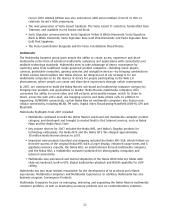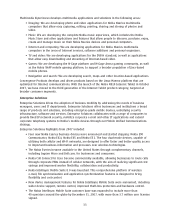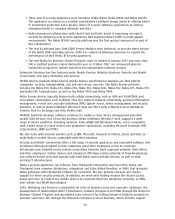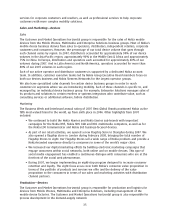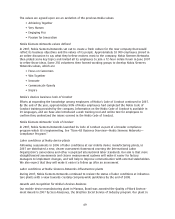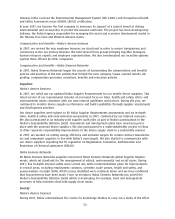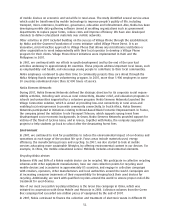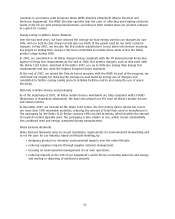Nokia 2007 Annual Report Download - page 43
Download and view the complete annual report
Please find page 43 of the 2007 Nokia annual report below. You can navigate through the pages in the report by either clicking on the pages listed below, or by using the keyword search tool below to find specific information within the annual report.network equipment. As global mobile subscriptions increase and data traffic rises, operators are
increasingly focused on marketing and differentiating their service offering, rather than on traditional
areas such as billing. This provides new business opportunities for Nokia Siemens Network with its
solutionsdriven approach to its operator customers.
At December 31, 2007, Nokia Siemens Networks had approximately 58 500 employees, 1 400
customers in 150 countries, and systems serving in excess of one billion subscribers. Highlights from
2007 included:
• The new company defined its values and introduced ethics and integrity guidelines, as well as
a compliance program, for all its employees.
• Nokia Siemens Networks showed its commitment to emerging markets with the expansion of
R&D capacity in Chengdu, China and the investment of USD 100 million to strengthen
operations in India. The company also moved its Services business unit to India.
• Deals signed in India included a USD 500 million network expansion contract with Idea Cellular
and a USD 900 million endtoend network expansion with Bharti Airtel; and in China a
EUR 180 million GSM/EDGE deal with Henan MCC.
• Nokia Siemens Networks won a deal with Sprint Nextel to become an infrastructure provider
for its 4G WiMAX network; won the first commercial deployment for its IHSPA solution with
TerreStar; won a trial deal with Verizon for LTE; and was chosen together with Panasonic by
NTT DoCoMo in Japan for its super 3G (LTE) base station project.
• Nokia Siemens Networks demonstrated the world’s first multiuser field trial in an urban
environment using LTE technology, which delivers data rates up to 10 times the current level.
Nokia Siemens Networks also became the first company to successfully deploy hybrid backhaul
in a live network, aimed at allowing operators to reduce costs while boosting capacity.
• The company signed a cooperation agreement with Intel in IPTV; and launched a new 3G
Femto Home Access solution and then struck Femto cooperation deals with Airvana Inc. and
Thomson.
• Nokia Siemens Networks announced an energy efficiency solution designed to lower
customers’ energy consumption and operating expenses.
• Nokia Siemens Networks reached a USD 935 million agreement on supplying 2G and 3G
network equipment to Zain in Saudi Arabia.
Nokia Siemens Networks Business Units
Nokia Siemens Networks has six business units:
Radio Access; Converged Core; IP Transport; Opera
tions and Business Software; Broadband Access;
and
Services.
These are supported by
Operations;
Research, Technology & Platforms;
and
Customer and Market Operations.
Radio Access
develops GSM, EDGE and 3G/WCDMA/HSPA radio access networks and cellular transmission
for operators and network providers. It also develops new technologies such as IHSPA, LTE and
mobile WiMAX to support the uptake of mobile data services and introduce flat architecture for
wireless and mobile broadband applications. The main products offered by Radio Access are base
stations, base station controllers and cellular transmission equipment. As data speeds evolve, these
products are increasingly used for data traffic in addition to traditional wireless voice traffic.
Converged Core
develops core network solutions for mobile and fixed network operators. The main
products are switches, different kinds of network servers and media gateways. Nokia Siemens
Networks circuitswitched network solutions are aimed at helping operators reduce the cost of
providing voice minutes to subscribers. Its packetswitched and Internet Protocolbased core network
solutions bring new functionality to the networks and are designed to enable operators to more
efficiently offer advanced services such as Voice over IP, or VoIP, calls; video sharing; IPTV; Presence;
42


